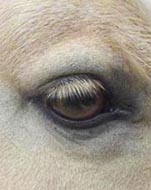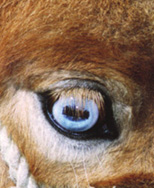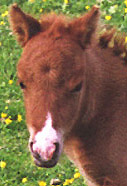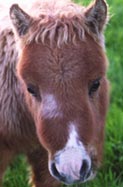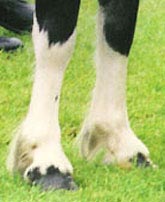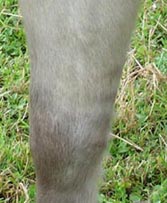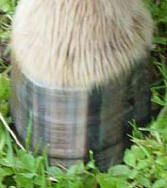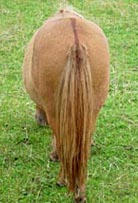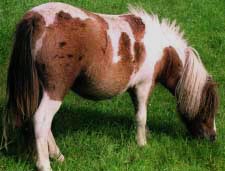|
|
|||
|
(The original of this article was written for the GEMS magazine of Dec. 2002) |
|||
|
All U.K. equines (horses, ponies, donkeys, mules) are required by law to have passports with a diagram of colour and markings. The diagram should record the basic colour and have at least 5 points that distinguish the individual animal. Sometimes it seems difficult to find at least five individual points of identification on whole coloured ponies. However, very often, distinctive markings are overlooked. Whorls Within the first two weeks of a foal’s birth, is the easiest time to find the whorls, where the coat parts to grow in a different direction, or where hairs meet to form a crest or tuft. All equines have feathered whorls at each stifle, a whorl at the poll under the forelock and one or more whorls on the forehead. The forehead whorl may be single or double. Sometimes there may be two whorls on the forehead. The exact situations of these forehead whorls differ from equine to equine, so are important. Other common areas where whorls may be found are on the chest, down the back of the legs, at the throat or on the top lip. However, they may occur anywhere, so try to check again when the foal is older as more may become apparent. The Head |
|||
|
Some obvious identification points are the white markings such as a star, blaze, snip or flesh mark on the head. Lip marks or chin spots are often overlooked. It is not uncommon to find a very few white hairs on the face of an otherwise whole coloured head. These should be noted. Eye colour should be noted. Do not assume that eyes are either dark or blue. Many ponies, palomino dilutes particularly, have light brown or tan coloured eyes, quite different to the normal dark brown. They should be looked at in good, but not bright, light. Some foals, often duns and palomino dilutes are born with blue eyes that darken over the next few months. It is also worth noting the colour of the insides of the ears. The inner ears of many black ponies are pale greyish colour, while chestnuts may have flaxen inner ears. Legs Most leg markings are also easy to spot, but,
unseen in the long summer grass, the small coloured spots called ermine
marks, on the coronet of a white sock or stocking, are often omitted
from passports. Care should be taken to record an accurate description of
the area of sock or stocking. A sock may cover the coronet or may extend
to include the fetlock. A stocking may extend to halfway up the cannon
bone or may extend over the hock or knee. Many dun ponies will have what
are known as primitive markings. On the legs, these show as
horizontal markings above the knee or hock, on the inside or outside, and
are called zebra markings. Hooves vary in colour too. Some dark
hooves are black while others are horn coloured. Many foals are born with
white hooves, but do not take it for granted that they will remain so.
After a few weeks, some will show dark horn growing in at the top. They
may grow in dark or they may develop stripes. Chestnuts often have flaxen
lower legs that should be recorded. |
|
||
|
|
|
||
|
|
|||
| The Body The body often has interesting identification marks. All duns will have a dorsal or eel stripe, even broken coloureds where there is colour over the back. The colour of the stripe varies and should be noted. Roan duns have white hairs through the eel stripe. Duns sometimes have what are known as shoulder shadows too, where there is an area of a slightly darker shade over the withers. Many non-grey and non-roan ponies have an increasing number of white hairs through the body coat. These should be noted as ‘roaning’ or ‘ticking’. Less usual markings sometimes appear on the body. Among these are Ben d’Or (or Bend Or) spots. These often cause confusion when they are taken to be part of the spotted pattern, but, in fact, are quite unrelated. Named after a famous Thoroughbred racehorse, they are dark spots or patches that may increase in size and number over the years. They are most apparent in chestnut based ponies, so may be seen on palominos, or chestnut roans, although they do occur in bays too. Small white spots on the body are called Birdcatcher spots, named after another Thoroughbred racehorse. |
|
||
| I have left the most obvious identifier until last. Usually the first thing to be noticed is the basic colour of the pony. We must remember that people from other countries may have to read the passports, so it is very important that they should be easy to translate into other languages. With this in mind, it is essential to use the normal horse terms to describe a pony’s colour. Terms such as ‘strawberry roan’ may have different meanings to different people and could mean the pony loses its registration by not matching the translated passport, so it is better to use the term 'chestnut roan'. Many foals change colour after birth so it is sensible to check the colour again just prior to registering the foal. If one parent is grey, the foal may go grey too, so look for any grey hairs growing around the eyes or through the body coat. A foal that may go grey should be recorded as the basic colour going grey or may go grey. A roan foal will have a lot of grey through the body coat but very little, if any, on the lower half of the legs. If one parent is dun, look for an eel stripe in the foal. A narrow or paler stripe may be more difficult to spot in a foal without parting the hair along its backbone. J. A. Allen’s "Photographic Guide to Horse and Pony Coat Colour" by Carole Knowles-Pfeiffer is a recommended and inexpensive illustrated guide to pony colour for those who would like to know more about basic colour. |
|
||
|
|
|||
| The message is, LOOK, LOOK and LOOK AGAIN. The more you look, the more
you will find and be able to record for an accurate passport.
Update. The law no longer requires whorls or markings to be drawn
on a passport application but they may perhaps help to identify an animal
should it be lost or stolen. All foals are now required to be microchipped
before they are weaned, leave their home or before the end of their first
year. Most microchips remain in place but there have been instances where
they have 'disappeared' or have even been removed. |
|||

